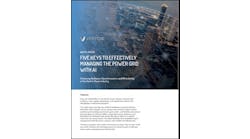Microgrid Knowledge Names Greater Good Award Winners at Microgrid 2023
The 2023 winners of the Microgrid Knowledge Greater Good Awards provide reliable power to communities and critical infrastructure in the face of severe weather and natural disasters, light to study by and fresh water to drink for children, and energy security to people with disabilities.
The awards were announced today at Microgrid 2023: Lights On!, a conference hosted by Microgrid Knowledge. This year’s event in Anaheim, California, drew more than 600 microgrid leaders, developers, innovators and users.
Microgrid Knowledge launched the award program five years ago to celebrate how microgrids can change the lives of those they serve. Here are the winners, chosen by an independent panel of judges.
Adjuntas Microgrid
The highest recognition prize went to the Adjuntas microgrid (Honnold Foundation and Community Solar Energy Association of Adjuntas [ACESA]) in Adjuntas, Puerto Rico.
Inspired by how well a local nonprofit’s solar project performed in the wake of 2017’s Hurricane Maria, a group of small business owners determined that a microgrid was the solution that would ensure reliable power when the island’s power grid could not. They formed ACESA, a nonprofit that now operates and manages the Adjuntas microgrid.
The project consists of two decentralized microgrids powered by nearly 700 solar photovoltaic (PV) panels and a 1.107-MWh battery energy storage system. The microgrid is designed to withstand hurricane force winds and can support the community for up to 10 days in the aftermath of a major storm.
Melissa Marshall, one of the judges and the director of policy and programs at The Partnership for Inclusive Disaster Strategies, praised the project, saying, “It is critical that control of energy in Puerto Rico rest in the hands of small business.”
“This is not simply a microgrid project; this is a new economic model and community building at its finest,” said Patrice Calise, another judge and copy editor at S&P Global Market Intelligence. “In addition to providing stable and affordable power for this community, the project takes into account local dynamics and issues of justice, which is reflected in the placement of solar panels and the ownership of maintenance and expansion. This microgrid belongs to the people here and will be able to withstand both social and climate challenges because of it.”
Atutu Solar Microgrid
The award for remote microgrid was presented to the Atutu solar microgrid (Atutu) in northern Myanmar.
This microgrid was installed at an off-grid monastery that serves as a boarding school for disenfranchised children. The school is currently home to 30 mostly ethnic minority students ranging in age from kindergarten to the fourth grade.
Before the microgrid, the monastery relied on a diesel generator to pump water and provide light at night. When the staff could not raise the funds to pay for weekly diesel fuel deliveries, students and teachers would have to carry water from a nearby river basin to the monastery’s water tanks, and students would be forced to study by candlelight at night.
The 5-kW microgrid, which also has a 9.6-kWh energy storage system, provides power on demand for students and teachers and has eliminated the monastery’s reliance on its diesel generator. Housely Carr, another judge and a writer/analyst at RBN Energy described the project as inspiring.
Gallaudet University Microgrid
The Gallaudet University microgrid (Scale Microgrid Solutions, Urban Ingenuity, CHA Consultants, Schneider Electric, Tesla, Mitsubishi, New Columbia Solar and Signature Renovations – Sworks JV) was awarded the prize for grid-connected microgrid.
Located in Washington, D.C., Gallaudet University is a top educational institution for deaf and hard-of-hearing students.
The microgrid consists of multiple distributed energy resource technologies including 2.5 MW of solar PV spread across numerous campus rooftops and parking garages, a 1.2-MW/2.5-MWh Tesla Megapack and 4.5-MW combined cooling, heat and power system. The system also features advanced microgrid controls to coordinate the seamless integration of the microgrid components and the broader power grid.
The microgrid will not only offset the university’s electricity demand, but it has enough solar capacity to serve some 1,500 households or businesses in the surrounding community.
The independent panel of judges found this project intriguing because it serves both the university and its neighbors. “It's great how the school thought beyond its own needs and sought to serve the broader community as well,” Carr said.
Calise agreed, adding, “This is the way forward for all universities.”
Redwood Coast Airport Microgrid
The award for a local microgrid in the conference’s host state was presented to the Redwood Coast Airport Microgrid (Redwood Coast Energy Authority, Schatz Energy Research Center at Cal Poly Humboldt, County of Humboldt, Community Choice Energy, Pacific Gas & Electric, Schweitzer Engineering Labs, Tesla, The Energy Authority and TRC).
Located at the Redwood Coast Airport in Humboldt County, California, this microgrid is the state’s first solar-powered, front-of-the-meter, multicustomer microgrid. It includes a 300-kW net metered solar PV array system that offsets daily electricity usage at the airport. It also includes a 2.2-MW solar PV array that feeds wholesale electricity directly into the grid and a 2.2-MW battery storage system providing 8.8 MWh of energy.
In addition to supporting the airport, the microgrid provides power to the nearby US Coast Guard Air Station during grid outages.
Last December, the microgrid was put to the test after a 6.4 magnitude earthquake rocked the county, leaving 70,000 customers without power. The microgrid performed perfectly, automatically islanding and keeping the airport and the Coast Guard Station powered for nearly 15 hours, despite suboptimal conditions – it was raining, the batteries had been partially discharged prior to the outage, and the outage occurred on the second shortest day of the year.
“The December 2022 earthquake provided proof of how valuable and helpful projects like this can be,” Carr said.
Track news about microgrids built for the greater good. Subscribe to the free Microgrid Knowledge Newsletter.








